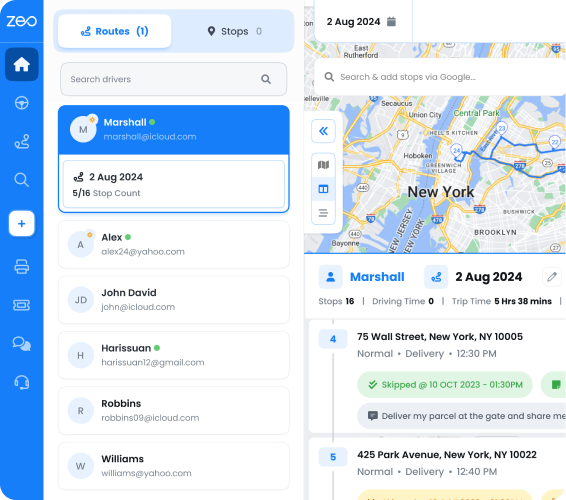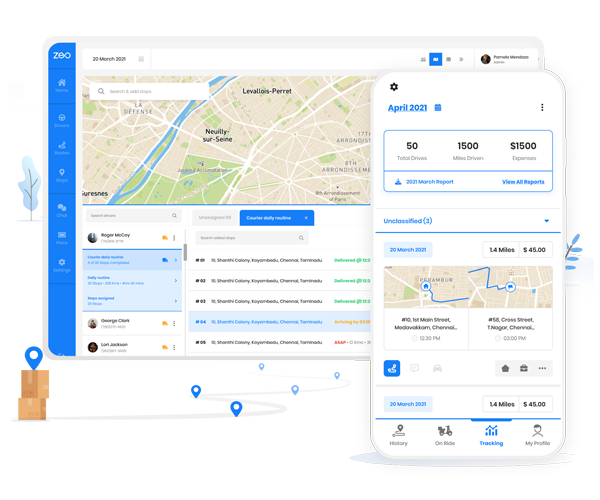Updated on: April 8, 2025
Fast, effective, and efficient delivery route planning forms the backbone of smooth logistics operations. Hence, last-mile delivery market is expected to grow at an 8.8% CAGR through 2030 from $132.71 billion in 2022.
Also, last-mile delivery accounts for 53% of total shipping costs. So, route optimization remains essential to cutting expenses and improving efficiency.
Excel offers simplicity and cost-effectiveness in route planning. A proper setup in Excel helps prioritize delivery group stops efficiently and even integrates with Google Maps for navigation.
Let’s unpack how to plan a delivery route using Excel, along with a free template to help you get started.
Delivery route planning with spreadsheets
Microsoft Excel might not be the first tool that comes to mind when planning delivery routes. However, small teams with limited technology access may opt for this.
Indeed, it is a manual process that is prone to errors. Still, if you follow the correct methods, it can get the work done.
Let’s explore how it all works.
Delivery route planning with spreadsheets
Businesses use spreadsheets for various purposes. The main task for the delivery route is listing orders, addresses, and schedule details in neat columns.
Formulas coupled with built-in features in Microsoft Excel can help identify urgent trips and addresses that are close together. It’s a basic version of route optimization software, but it’s definitely handy for those who want a
quick solution.
How do you make it happen in Excel?
With Excel at the center of your delivery route planning, there are several steps you need to take.
These are as follows:
- Data Organization: Organize your orders, addresses, and order IDs in clear rows and columns. Also, add extra fields such as delivery deadlines and special instructions.
- Sorting & Filtering: Excel’s sort functions enable grouping deliveries by location or time slots to reduce guesswork when planning multiple drop-offs.
- Distance Estimation: While Excel doesn’t come with built-in distance calculators, you can use simple data entry or formulas to track distances if you have them.
- Time Slot Prioritization: Some orders need to be delivered before a specific time. Create a “priority” column and mark these orders so that you can schedule them first.
- Color-Coding & Conditional Formatting: Use colors to highlight urgent orders or tasks that are behind schedule. This offers a quick snapshot of what needs attention.
The above steps can provide more structure for your daily tasks. It’s a bit manual compared to modern route optimization software, but it’s a great way to ensure everyone on your team is on the same page.
Using Excel with Google Maps route planner
Pairing Excel with Google Maps can give your team even more clarity. Think of Excel as your data storehouse and Google Maps as your route visualization tool.
Together, they pack a punch when it comes to delivery route planning.
Example:
If you have 10 addresses in central London, list them in Excel, export them to Google Maps, and shuffle them around to see different route options. Once you finalize your plan, update your Excel file. This old-school method is super-handy for smaller-scale delivery route planning.
Here’s a simple way to do it:

increase fuel savings
Save 2 Hours on Deliveries, Everyday!
Optimize routes with our algorithm, reducing travel time and costs efficiently.
Get Started for Free
Prepare Your Data in Excel:
List delivery addresses in one column. Add columns for order IDs, recipients’ names, and special notes.
- List Addresses: Create a column dedicated to delivery addresses. Ensure each address is complete and accurately formatted.
- Additional Details: To provide comprehensive information, include columns for order IDs, customer names, and any special delivery notes.
Generate a Shareable Link:
Copy your address column and prepare it for Google Maps. If you have many addresses, consider special add-ons (such as “Google Maps Excel Add-in” or scripts) that convert your list into a map-friendly format (CSV or plain text).
- Use an Online Tool: Utilize tools like BatchGeo to convert your Excel data into a map.
- Upload Data: Copy and paste your Excel data into the tool to generate a map with all your delivery points.
- Create Link: Once the map is generated, create a shareable link that your team can access.
Share with Your Team:
Next, you should let the last-mile delivery partners use this information. Therefore, there are a couple of steps to follow.
- Distribute Link: Share the generated link with your delivery team, allowing them to access the planned routes on their devices.
- Real-Time Updates: Any changes made in the tool can be reflected in real-time, keeping everyone informed of updates.
Downloadable Excel Template
A Microsoft Excel workbook is available for download. It has customizable field for Addresses, Priority, Estimated Delivery Time, Order Notes, and more.
Using route optimization software to create better routes
While Excel combined with Google Maps is a good stepping stone, there are times when you need heavier horsepower. That’s where specialized route optimization software comes in.
Tools like the Zeo Route Planner take location data from multiple stops and figure out the shortest or fastest path in a flash. This can be a lifesaver when you’re juggling dozens or even hundreds of deliveries.
Zeo Route Planner, for example, is mobile-friendly, so drivers can see live routes, handle parcels, and even get analytics on route performance. These capabilities make scaling up easier, helping your team reduce wasted trips and stay focused on key tasks.
That’s the big difference compared to manually arranging routes in Excel—less guesswork, more real-time awareness, and happier customers.
Here’s what such a system does for you:
- Instant Sequencing: You load a bunch of addresses, and the software creates a smart route order.
- Group Management: In case you have multiple drivers, the app splits the deliveries and suggests separate routes.
- Tracking & Analysis: Some platforms include data on travel times, missed deadlines, and cost tracking.
- Easy Collaboration: Since most of these tools work with mobile apps, drivers get immediate updates on changes.
Conclusion
Excel is a great starting point for delivery route planning, especially for teams looking for a free and structured way to manage deliveries. It allows you to organize addresses and group stops and even integrate with Google Maps to visualize routes. However, as operations scale, Excel becomes time-consuming and lacks automation.
For businesses handling high-volume deliveries, switching to dedicated route optimization software like Zeo Route Planner is a game-changer. Unlike spreadsheets, Zeo Route Planner automatically optimizes routes and distributes stops efficiently—all within seconds. Live tracking, mobile access, and multi-driver support remove the manual hassle and help businesses cut costs while improving delivery speed.
Ready to move beyond manual route planning in Excel?
Book a demo for Zeo Route Planner to avail yourself of a smarter, faster, and more scalable solution that streamlines your deliveries.

Are you a fleet owner?
Want to manage your drivers and deliveries easily?
Grow your business effortlessly with Zeo Routes Planner – optimize routes and manage multiple drivers with ease.

increase fuel savings
Save 2 Hours on Deliveries, Everyday!
Optimize routes with our algorithm, reducing travel time and costs efficiently.
Get Started for Free





















